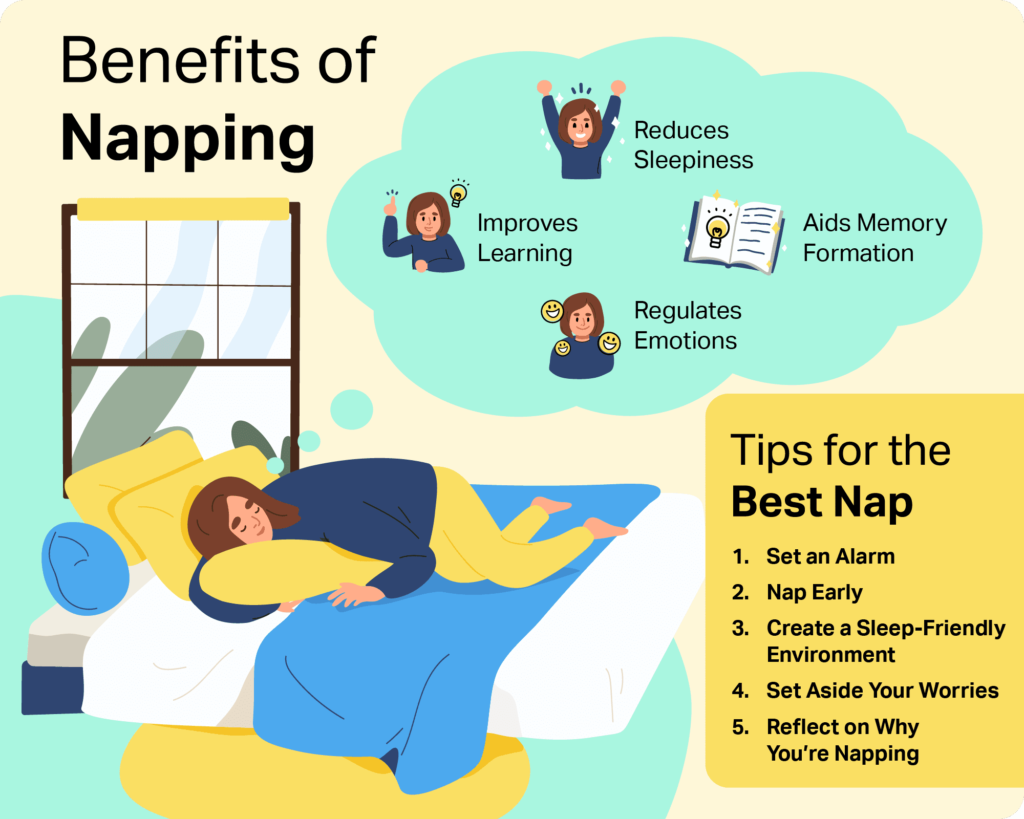
To get the full benefits from nap time, it is important to consider where, when, and how long to nap. These and other factors can influence how a person will feel after waking up from a nap.
In general, the best nap length for adults is about 20 minutes and no longer than 30 minutes. Sleeping for 20 minutes allows the napper to get a bit of light sleep to boost alertness without entering into deep sleep. Waking up from deep sleep can cause grogginess and actually worsen sleepiness.
In some cases, a longer nap of around an hour and a half may also be beneficial. This length of time allows the body to cycle through the stages of sleep and avoids interrupting deep sleep. This type of longer nap may be especially helpful for emergency workers and shift workers who are trying to avoid fatigue.
Napping may be too much if it interferes with sleep at night. Sometimes a nap of 90 minutes or so can be refreshing, but it may be problematic if it happens too late in the day. Dependency on naps, rather than consistent nighttime sleep, can contribute to fragmented sleep or sleep disorders such as insomnia.
However, naps may not affect everyone in the same way. Some research suggests that napping affects nighttime sleep primarily in older adults rather than young and middle-aged adults.
Experts typically recommend that adults take naps eight or more hours before bedtime. For most people, that means napping before 3 p.m. Napping too late in the day may contribute to nighttime sleep problems.
For some people, naps may feel natural or even necessary after lunchtime. This is sometimes known as the post-lunch dip. While eating lunch may play a role in afternoon sleepiness, the post-lunch dip is linked to circadian rhythm. Circadian rhythm is the body’s internal clock that follows a 24-hour cycle. Within this cycle are two peak periods for sleepiness. The greatest peak is during the night, and the second one falls in the early afternoon.
A good sleep environment is cool, quiet, and dark. Having a comfortable nap setting can help prevent unwanted interruptions or awakenings.
For people who work from home, a bedroom is likely a good place for a short snooze since it is already set up to promote sleep. Adding blackout curtains or a white noise machine to block out distractions may help both at night and during daytime naps.
In an office setting, accessories such as earplugs or an eye mask can reduce disruptions during nap time. When possible, naps should be taken in a space where interruptions are unlikely to occur. Some offices may even have nap pods or other quiet areas for relaxation or a short period of restorative sleep.
Before dozing off during nap time, set an alarm for the desired nap length, which should generally be around 20 minutes.
When the alarm goes off, do not hit snooze to keep sleeping since this can risk entering deeper sleep. Setting a second alarm to go off shortly after the first one may help to avoid napping for too long.
Try to get up as soon as the alarm sounds and then stretch or walk around to shake off any post-nap sleepiness.
People taking a nap to get a boost of energy may benefit from drinking caffeine before napping. The brain and body feel the impact of caffeine about 30 minutes after it is consumed, so having caffeine right before a short nap may increase alertness after waking up.

In many cases, napping longer than 30 minutes can result in grogginess and diminished performance after waking up. In other words, napping too long can undermine the purpose of the nap. For any individual, it is important to reflect on daily energy levels and the duration and frequency of naps. If daytime sleepiness is negatively affecting you on a regular basis, it may indicate a need to change sleep habits.
For most people, the best time to take a nap is either just before or during the post-lunch dip. The post-lunch dip is the period of decreased alertness and productivity often experienced after a midday meal. A brief snooze around this time may help reduce afternoon sleepiness without interfering with nighttime sleep.
Newborns, infants, and toddlers require more sleep than adults, and it is common for them to have sleep periods during the day that supplement the sleep they get at night. Babies may take one or more naps per day, depending on their age, while toddlers tend to take only one nap each day. Similar to adults, toddlers’ nap times should occur well before bedtime.
Also like adults, children’s nap environments should be free of noise, excess light, or other distractions. Over time, children may reduce the time they spend napping or stop napping altogether.
Your current napping habits may not fit perfectly with expert recommendations, but that does not necessarily mean the way that you nap is wrong. You should only change your napping habits if you are having problems with your nightly sleep or your daily energy level.
If you are not a regular napper, change may not be necessary. If you are able to function well each day without a nap, then napping may not be something you need to incorporate into your daily schedule.
You may have to experiment with the timing, duration, and location of your nap. Consider keeping a nap diary where you can record your sleepiness or fatigue levels before and after your nap, as well as where, when, and how long you napped. These recordings can help you track what type of nap is most effective for you.
Excessively napping can also be a symptom of a mental health disorder such as anxiety or depression. Contact your doctor if you are experiencing other related symptoms, such as low mood, change in weight or eating habits, or a lack of interest in activities that you would normally enjoy.